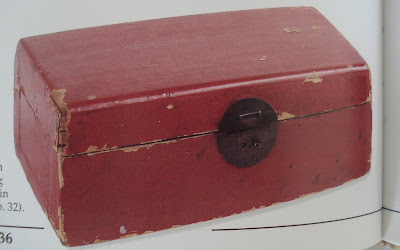
The shawl from 1845 is done, and blocking.
I have weaved in ends but will wait to cut them until it is completely dry. Whenever I work these old patterns I sit and memorize what I know about the period.
 The author of the pattern was a head principal and perhaps she has used this pattern for her pupils. It is an easy and fun knit and the colors and symmetry will appeal to girls. Even today. The colors are extremely bold. However, people at that time really loved the new chemical colors that did not fade like the old ones. From a book about Van Gogh I have taken some funny photos to remind me how extreme the paintings were at that time.
The author of the pattern was a head principal and perhaps she has used this pattern for her pupils. It is an easy and fun knit and the colors and symmetry will appeal to girls. Even today. The colors are extremely bold. However, people at that time really loved the new chemical colors that did not fade like the old ones. From a book about Van Gogh I have taken some funny photos to remind me how extreme the paintings were at that time.

Van Gogh had a Japanese lacquered box in which wools were kept.

He used to make up combinations of complementary colors.

I recommend this pattern for people who work at open air museums in the period 1845- 90. It is an easy way to dress up for an original urban Victorian outfit.
Van gogh had a wool box. I love it. The close up of the photo looked like tapestry.
ReplyDeleteI am very happy to have found your blog through Ravelry!
ReplyDeleteI dance with a Scandinavian folkdance group in Manitoba, Canada, and we have to make our own costumes.
I have been wanting to find a pattern for a shawl for a very long time, and I'm very happy to have found yours, (but it is still too difficult for me right now.)
However, every good knitter enjoys a challenge, right?
While I knew about the fad for bright aniline dyes during this period, seeing a pattern in the colors that were intended is still quite a surprise. The gray and white part at the top seems so very different from the hot pinks and black below. Almost quiet.
ReplyDeleteYou are right, Ana. I have heard that people overdid the colors because they were fading. It just did not happen with the aniline dyes.
ReplyDeleteThe tie-shawl must be perfect for dancing. Write to me again when you are ready for a small challenge.
ReplyDeleteArtificial colours were probably as exciting then as hand-dyed ones are now. We're always looking for change. I think that another reason people liked bright colours was because lighting was much more sombre than it is now. When eighteenth-century rooms are restored to their original colours, they often look rather garish in electric light but are pretty in candlelight. Lovely shawl.
ReplyDeleteThanks Helen. I have had the same thoughts. In the period 1890 - 1910 the colors are black,brown and khaki.
ReplyDeleteOh That is lovely!!
ReplyDelete